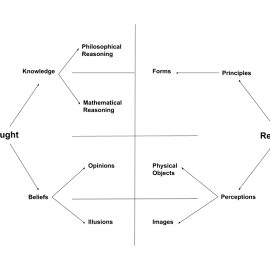

This article is an excerpt from the Shortform book guide to "A Brief History of Time" by Stephen Hawking. Shortform has the world's best summaries and analyses of books you should be reading.
Like this article? Sign up for a free trial here .
Is the future predetermined by the laws of physics? Is free will an illusion? What is scientific determinism?
We could predict the state of the universe at a given time—even a time in the future—if two things were true: we have a unifying theory of physics, and we’re able to measure the state of the universe at any given time. This would be “scientific determinism,” and physicist Stephen Hawking explains its limitations in A Brief History of Time.
Read more to learn Hawking’s insights on this intriguing matter.
Scientific Determinism
What is scientific determinism? Scientific theories allow us to model the behavior of objects and make predictions about future observations or the outcomes of experiments. Hawking points out that if we could formulate a unified theory of physics that could be applied in any context, then if we knew the exact state of the entire universe at any point in time, we could use the theory to predict the state of the universe at any other time. This would make human free will an illusion, since we could calculate everyone’s future actions. Hawking refers to this as “scientific determinism.”
However, Hawking also discusses three limitations of scientific determinism:
- Scientists have not yet been able to find a unifying theory of physics.
- The theory of quantum mechanics (one of the major theories in modern physics) gives results in terms of probability, rather than deterministic results.
- The uncertainty principle of quantum mechanics limits our ability to measure the state of the universe at any given time, so even if you had a unified, deterministic theory, you couldn’t measure the present state of the universe accurately enough to exactly predict its future state.
We’ll examine each of these limitations in more detail.
No Unifying Theory
Hawking asserts that the ultimate goal of science is to develop a “unifying theory” that can be applied in any context. Scientists have made progress towards this goal, but have not yet achieved it. Instead, scientists currently use two major theories: general relativity and quantum mechanics. Each of these theories makes accurate predictions when applied in its intended context, but the intended context of the two theories is very different. Additionally, if you try to apply both of them in one of the rare cases where their applicable context overlaps, you run into problems.
The Limitations of General Relativity
To accurately model the motion of objects as they approach the speed of light, Hawking says we must use the theory of general relativity. This theory works great for predicting the motion of stars, planets, and macroscopic (big enough to see without a microscope) objects in general. However, Hawking notes that relativity does not accurately model the behavior of subatomic particles. The reason for this has to do with the nature of particles.
The Limitations of Quantum Mechanics
Like the theory of relativity, the theory of quantum mechanics has limitations that prevent it from being a unifying theory. Unlike relativity, quantum mechanics accurately models the behavior of subatomic particles and their interactions with electromagnetic and nuclear forces. However, according to Hawking, quantum mechanics doesn’t allow for modeling gravitational interactions or macroscopic objects.
As Hawking explains, the reason quantum mechanics doesn’t provide a model of gravity is that the mass of the subatomic particles that we can observe is so small that the effect of their gravitational attraction to each other is too small to measure. However, we can’t simply add more particles to make them easier to measure: According to Hawking, as the number of particles in a quantum-mechanics problem or simulation increases, the complexity of the calculations also increases. It takes so many atoms to build even a speck of dust that the problem becomes too complex to solve.
Probability and Quantum Mechanics
Quantum mechanics is able to accurately model the behavior of subatomic particles because it takes into account the wave-particle duality of matter and energy. However, using quantum mechanics imposes another limitation of scientific determinism, because quantum mechanics doesn’t provide deterministic solutions.
Hawking explains that if you model the motion of a particle with quantum mechanics, you get a probability map, showing you where the particle is most likely to go and where it is less likely to go. He explains that this is because, to model the wave-particle duality of matter and energy, the theory assumes that a particle simultaneously travels every possible path that it could take. The probability map comes from calculating how waves taking these different paths would interfere with each other.
(Shortform note: There is a connection between the mathematical field of statistics and the theory of quantum mechanics because quantum mechanics provides probabilistic solutions instead of deterministic ones. However, statistical mathematics used in quantum theory is different from what’s used in traditional statistics. This is mostly because traditional statistics usually deals with only one or two variables at a time, while quantum theory has to manage a larger number of variables at once. Nevertheless, mathematicians are beginning to adapt methods from quantum mechanics to general statistical modeling. This is creating new mathematical tools for statistical analysis and new types of statistical metrics.)
The Uncertainty Principle
Quantum mechanics provides probabilistic solutions instead of deterministic ones, and that limits scientific determinism. But there’s another limitation on determinism that comes from quantum mechanics as well: the uncertainty principle.
As Hawking explains, the uncertainty principle states there is always at least a certain amount of uncertainty in your measurement of the position and velocity of a particle. This is important because to predict where a particle will go (or is most likely to go) in the future, you need to know where it was and which way it was going at some point in the past or present. Uncertainty about the present creates greater uncertainty about the future.
Recap
So, is the future predetermined by the laws of physics? Well, it might be, if there is a theory that completely defines how the universe works. But so far, scientists have not been able to find such a theory.

———End of Preview———
Like what you just read? Read the rest of the world's best book summary and analysis of Stephen Hawking's "A Brief History of Time" at Shortform .
Here's what you'll find in our full A Brief History of Time summary :
- The search for a theory that explains the history and evolution of our universe
- Stephen Hawking's discussions about time, space, dimensions, and quantum theory
- How time travel would theoretically work






